- AWS Solutions Library›
- Guidance for Cross Region Failover & Graceful Failback on AWS
Guidance for Cross Region Failover & Graceful Failback on AWS
Overview
How it works
Application Running in Primary Region

Cross Region Failover

Deploy with confidence
Ready to deploy? Review the sample code on GitHub for detailed deployment instructions to deploy as-is or customize to fit your needs.
Well-Architected Pillars
The architecture diagram above is an example of a Solution created with Well-Architected best practices in mind. To be fully Well-Architected, you should follow as many Well-Architected best practices as possible.
This Guidance supports operational excellence by making sure that the business can continue to run business services through failover to a secondary region.
Read the Operational Excellence whitepaperUse WAF with CloudFront to protect application from common vulnerabilities and use Amazon Cognito to authenticate UI and API access.
Read the Security whitepaperAutomate failure monitor workload’s key performance indicators (KPIs) and trigger automated failover when a threshold is breached.
Read the Reliability whitepaperUse Amazon API Gateway and Lambda to process transactions in order to avoid provisioned compute resources.
Read the Cost Optimization whitepaperThis Guidance is serverless and minimizes your carbon footprint.
Read the Sustainability whitepaperDisclaimer
The sample code; software libraries; command line tools; proofs of concept; templates; or other related technology (including any of the foregoing that are provided by our personnel) is provided to you as AWS Content under the AWS Customer Agreement, or the relevant written agreement between you and AWS (whichever applies). You should not use this AWS Content in your production accounts, or on production or other critical data. You are responsible for testing, securing, and optimizing the AWS Content, such as sample code, as appropriate for production grade use based on your specific quality control practices and standards. Deploying AWS Content may incur AWS charges for creating or using AWS chargeable resources, such as running Amazon EC2 instances or using Amazon S3 storage.
References to third-party services or organizations in this Guidance do not imply an endorsement, sponsorship, or affiliation between Amazon or AWS and the third party. Guidance from AWS is a technical starting point, and you can customize your integration with third-party services when you deploy the architecture.
Did you find what you were looking for today?
Let us know so we can improve the quality of the content on our pages